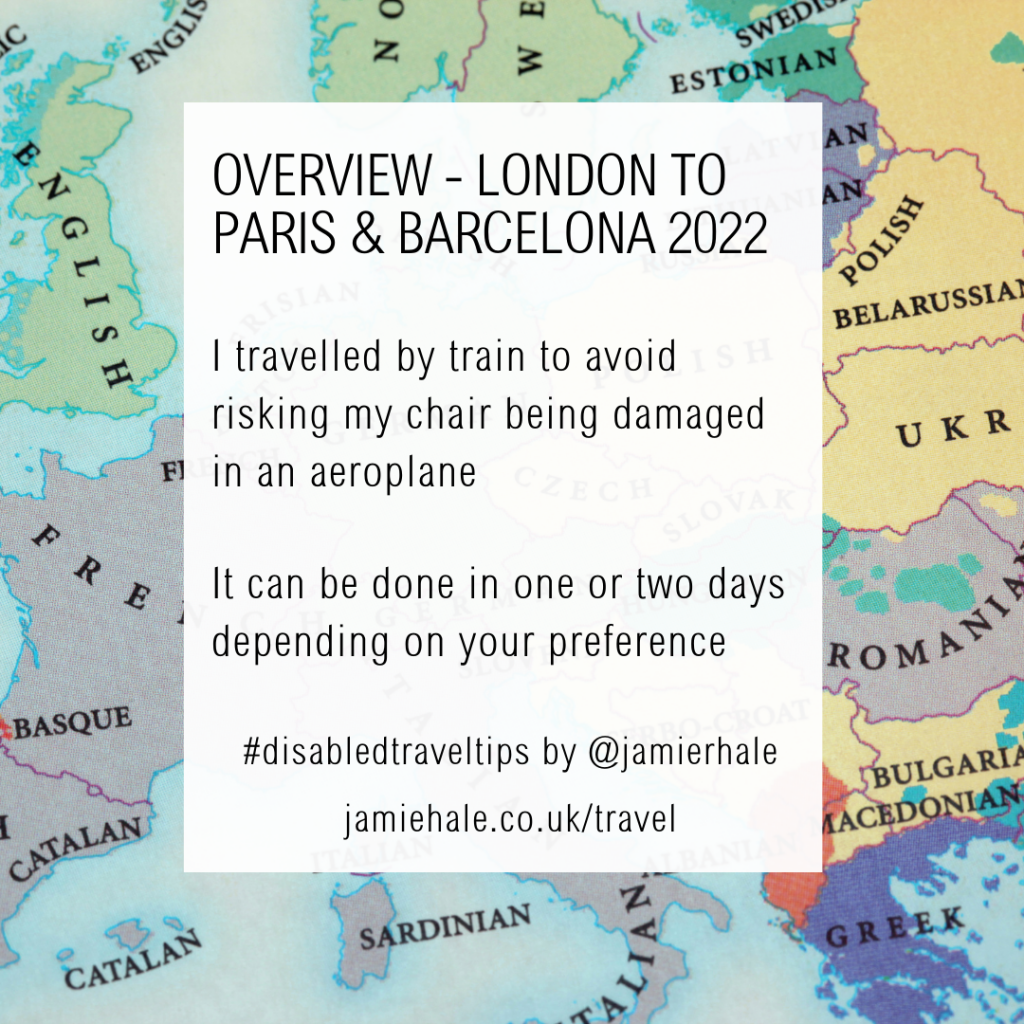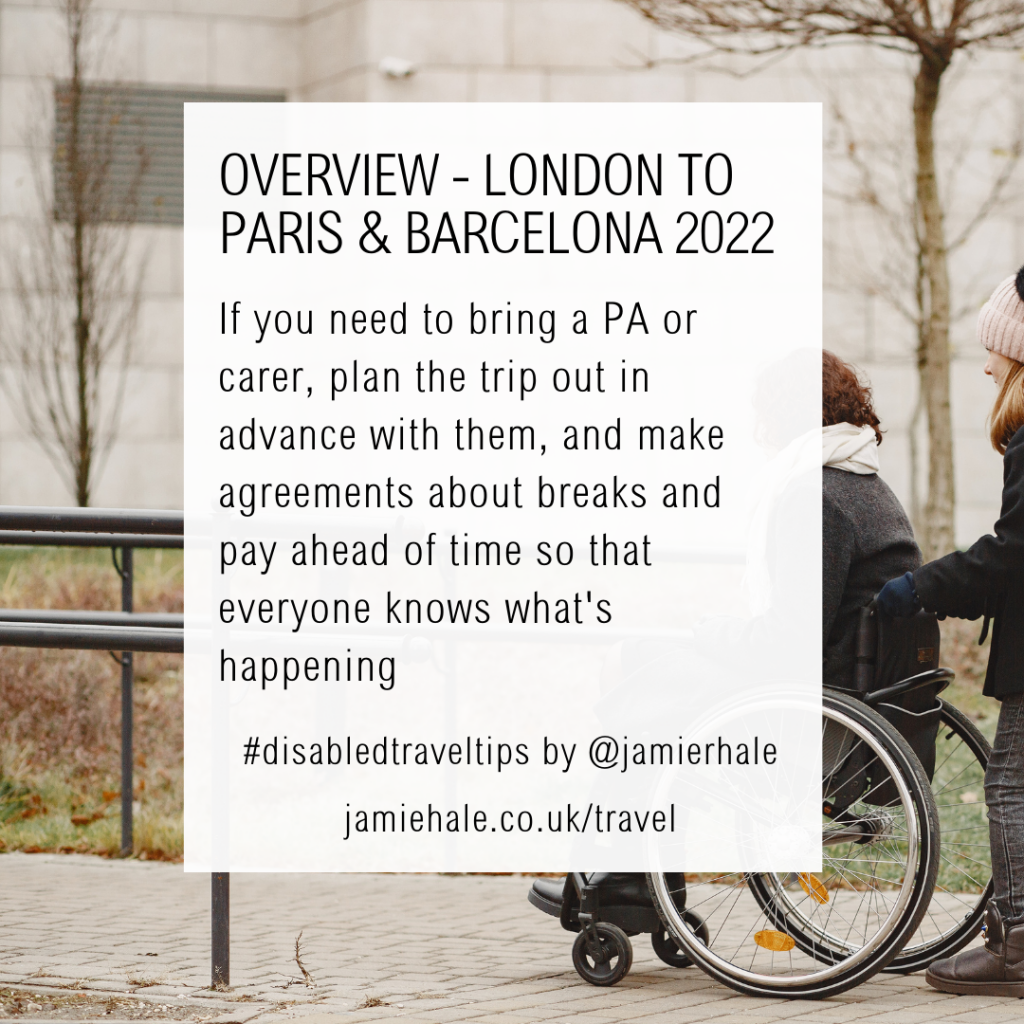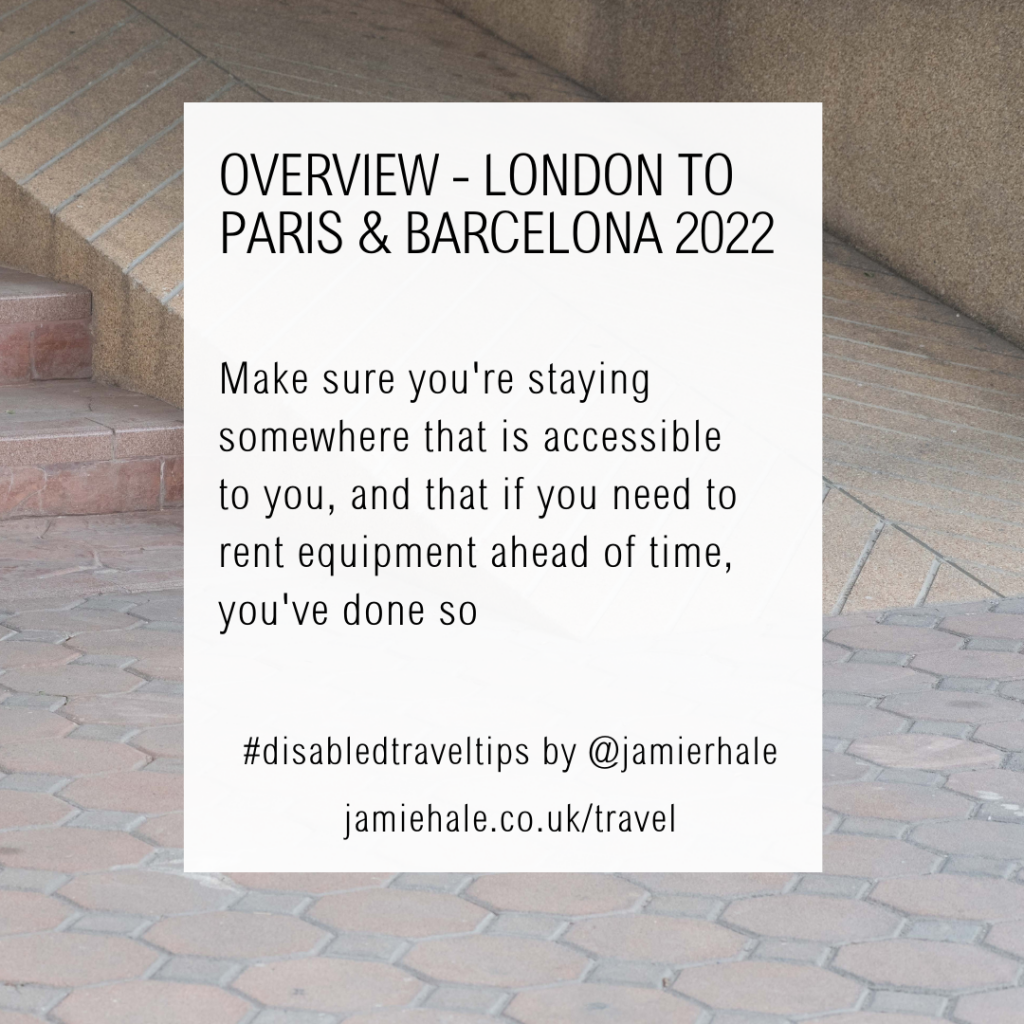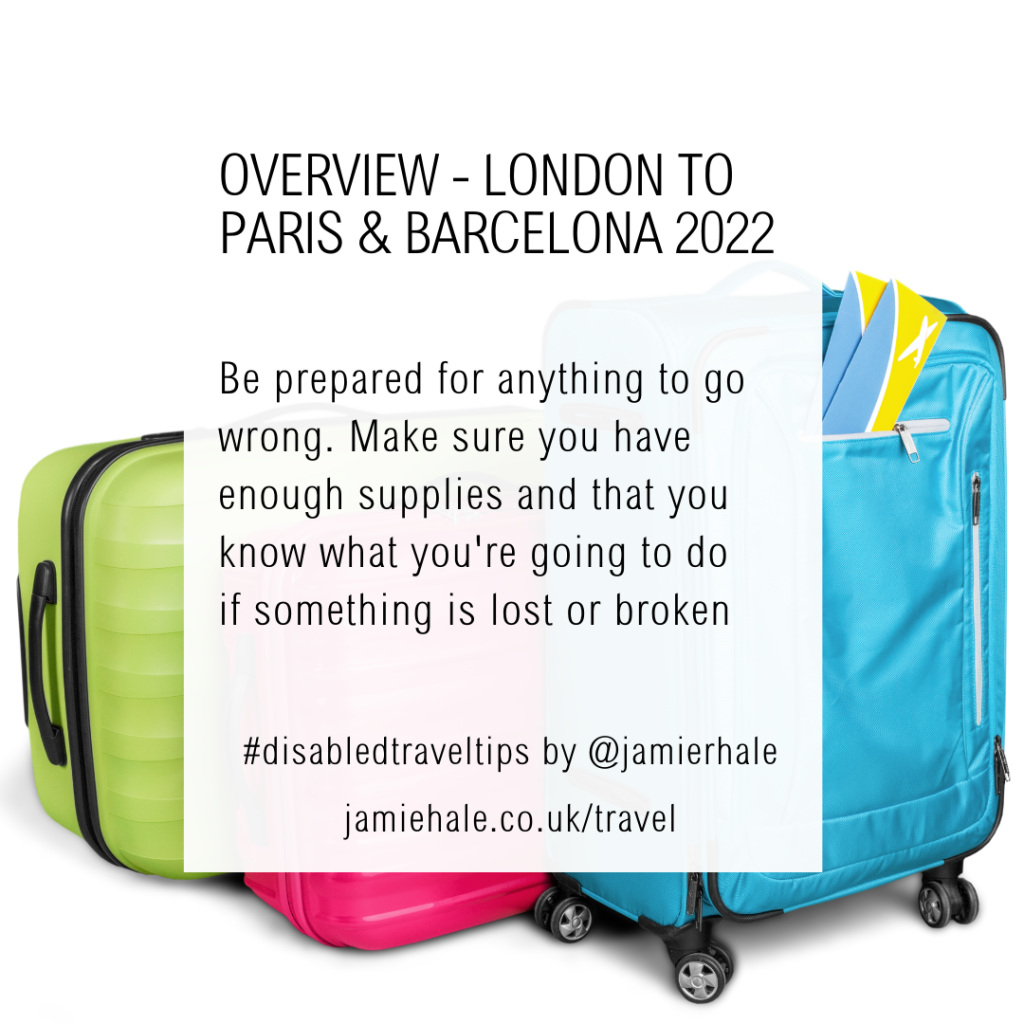I was lucky enough to book a to Paris and Barcelona while disabled . This both developed and tested my knowledge about accessible travel. With everything I worked out about the trip – from packing to itinerary, I decided to write a series of blogs. These cover everything from travel and accommodation to places to stay, activities, and advice on travel as a disabled person.






Planning a trip while disabled
Planning a trip is usually a mixture of great fun and a lot of stress for anyone. Whether it’s destination, accommodation, transport, dates, or activity, all of this arranging is delightful when it goes well. When it goes badly, it’s a nightmare. I do find planning is part of the fun of travelling.
However, planning a trip when disabled is another metaphorical kettle of fish. I didn’t just have to plan a normal trip, but I had to handle all the complexities of being disabled. From shipping supplies to figuring out lift dimensions, getting these things right is absolutely crucial – and definitely not easy.
When I decided to take a research and writing trip to Barcelona, I had to think about:
- Travel
- Care
- Accomodation
- Medical equipment and supplies
Travelling from London to Barcelona
As I am not a driver and do not have a car, driving to Barcelona wasn’t an option. I feel like the coach journey of at least 26 hours was also likely to be both inaccessible and awful. This meant that my two main options were either to fly, or to take the train. With all the recent issues with disabled people and flying, so I decided to take the train, but why?
Flying
I have flown between London and Barcelona frequently. However, the more I need very specialist wheelchairs, the more of a challenge it would be if the airline broke my wheelchair. The chairs I have have sustained some (mostly minor) damage on previous flights. If something happened to my chair, my whole trip would have been ruined.
On top of that, there were two other key factors which made me wary of flying . One was the airport chaos this summer, and the other the catastrophic assistance failures.
After so long shielding – and emerging sporadically between vaccine doses ,I’m not used to being in crowds. While I’m very familiar with flying, and especially flying that route, I know getting through airports is utterly awful.
I’m also very used to failing to be met by Special Assistance. I’ve spent hours stuck on an aeroplane long after the other passengers. While that’s frustrating and awful, it’s not the end of the world for me. However, as the news stories show, it’s still happening frequently I hate it when I get onto the plane last. I feel very visible (because I am) and often like I am holding up the plane as a group of men wrestle me into my seat. Always a window seat – to make it easier to leave me behind if the plane has to evacuate. Frightening thought!
Trains
The alternative was to get the Eurostar. I love the Eurostar. It’s usually under £40 per person each way for a disabled person plus companion (making a return under £160). This includes an upgrade to standard premier class, with business class lounge (free unlimited alcohol, incredibly). The discount only allowed one companion – which I will come to later. After the Eurostar, I could get another train from Paris to Barcelona while disabled
Scheduling trains
I initially planned to get the first Eurostar of the morning on the first day of my trip. This arrives in Paris with about 4 hours to get from Gare du Nord to Gare de Lyon – about an hour’s walk apart. There are two direct trains from Barcelona to Paris each day. If you’re travelling up by Eurostar that day, you can only catch the later of these. This means that if the train company cause a delay, you could end up being trapped in Paris overnight unexpectedly. I love Paris, but the trip was meant to be to Barcelona and I didn’t fancy trying to find an accessible hotel in Paris at the last minute.
However, after a friend’s Eurostar was very delayed, I rethought this plan. I realised that if I failed to make it across Paris in time due to delays, I’d be trapped. So I decided it was better to stay the night in Paris first. This extended the trip by a day, but also meant that if there were delays on the Eurostar, I could still make it on to Barcelona.
This made the trip a day longer – which was not a bad thing . However, it obviously added expense which is frustrating. It’s a situation in which, were I not disabled, I wouldn’t have worried about this at all. I’d have known I could leap in a cab between stations, and that it would be easy to find a hotel or hostel if I had to.
On the way back, I decided to do the whole trip in a day, and it was broadly very successful. The train between Paris and Barcelona ran smoothly, and I got to Paris with plenty of time. This turned out to be very lucky. Once there, it was impossible to get a wheelchair adapted taxi between Gare de Lyon and Gare du Nord. Too intimidated to work out the bus system in Paris, I had to do the hour’s trip on wheels. This turned out fine – the four hours I had between trains was plenty. That said, if you were in a manual wheelchair, it could be quite a push!
Care
Another challenge with planning a trip of what became 9 days was how to manage my care needs. I have 24hr care, and obviously nobody can work 24 hours a day for 9 days in a row! However, the cost of bringing PAs was prodigious – and there’s no funding to cover that. I have the advantage of being able to get some support from a companion travelling with me. That person also couldn’t work round the clock – and nor would they want to! Here that the only option became to bring PAs with me and eat the cost.
I was lucky that within my existing team, there were some great people who loved the idea of a trip to Barcelona. This meant I was able to do the trip with their support. Because I was getting the train – and the Eurostar discount only covers me + one companion the train was too expensive, so they flew and met me there.
I was also lucky that I could make this work thanks to the help of my companion travelling with me . It is a privilege to have the kind of people in my team who wanted the travel – and I know that it wouldn’t be an option for everyone.
I had to personally cover the costs of their flights and hotel – but this is the cost of travelling while disabled. It shouldn’t be – but I’m very lucky to have been able to do this trip.
Accommodation
The next of the pre-trip decisions I had to make was where to stay. There were lots of different factors to navigate with that. Once we’d decided to spend a night in Paris, we had to find somewhere suitable there. What I needed in Paris and Barcelona were very different.
Having been to both cities quite a few times, I knew that in Paris I just wanted an accessible hotel.My hopes for Barcelona were rather higher.
Paris
Recent trips to Paris have had me staying in a range of inappropriate hotels which were not accessible – such as the Ibis Styles Paris Lafayette Faubourg-Montmartre, where the bedroom door barely closed, and where the toilet required the seat removing and me tying to a range of items to keep me safe on it.
This time, I booked another Ibis – Ibis Paris Bastille Opera 11ieme – (because they’re reasonably affordable)). This was nearer Gare de Lyon than Gare du Nord, and it was a far better decision. Why not read more about it here?
Ultimately I wanted somewhere reasonably near the stations, and access provisions were lower down the list. With a willing companion, I decided most things can be lumped for a single night.
Barcelona
Choosing somewhere to stay in Barcelona, I had different priorities. The longer the trip, the more necessary an air mattress and hoist are. Given I’m capable of getting pressure sores on a circulating air mattress, a long trip without a circulating air mattress would start to become worrying. Similarly, a profiling bed is very necessary – and access to a proper adapted bathroom I can use.
MICs Sant Jordi
At the outset, this sounded impossible – but then I remembered Simply Emma’s blog on MICs San Jordi – and that sounded like the perfect solution. They operate as a mixture of a care home, a rehab place – and they take tourists. They even have apartments. For me, this was the dream. Having lived in Barcelona and Córdoba, I feel strange in a hotel when in Spain, and on a trip of this length, I wanted to feel like I was living in Barcelona.
Given that I would have needed two hotel rooms – getting an an apartment was actually about the same price – and that the idea of having a washing machine meant less luggage, a kitchen meant we could keep some food in, rather than having to dine out for every meal, and overall, it just sounded like a far better plan.
I will write more about MICs Sant Jordi when I talk about accommodation – but from the outset of my contacting them, they were excellent, supportive, very responsive by email, and went above and beyond for me. After booking, they also offered me a 5% discount on my stay for writing about them on social media – which I was going to do anyway.
If you’re not staying somewhere specifically adapted, you may need to rent things like a profiling bed, or a hoist. They’re available to rent in most countries, and if you speak to the place you’re staying, they’re reasonably likely to be accommodating I’ve found.
Medical supplies
The shipping disaster
The last piece of the puzzle in terms of major planning was where it went most wrong – medical supplies. There are lots of equipment and supplies needed to manage my bladder, bowel, ventilation, medication delivery, injections, and feed supplies. I had no idea how I was going to transport a week’s worth of supplies. After that, I had an amazing (but ultimately, dreadful – don’t get your hopes up) idea. I decided to ship them to Barcelona, to arrive before I was due to leave (so I could be sure they got there). MICs Sant Jordi were very happy to receive this package.
That was a relief. Once I’d packed the essential supplies for the Barcelona leg of the trip, I had a 15kg box, 75x35x35cm. I packed it to the brim. I sent it on a 3-5 day shipping, and it cost about £33 to do so. Carefully I didn’t put in any medication and while some of the things in it were prescribed nothing was prescription only. This was crucial, because I wanted to be sure it would clear customs. I bought shipping and I thought I’d solved my packing issue.
The customs problem
Following the tracking, I watched it land in Barcelona. However, I then got an email to tell me that they needed a delivery phone number. After a series of issues and contacts it became clear that since the UK had left the EU, this box would need a pharmaceuticals import licence. Nothing in it was prescription only, so this was a nightmare
Without that, I was told that if I had had “clothes and books” written on the box, there would have been no issue. Since I’d written what was in it, there was no way it would get through customs. There’s some confusion over whether, if this had been going to a residential address instead of a business, it would have been okay. Ultimately it was not, and the parcel, as I travelled off to Spain was on its own trip back to England.
Last-minute packing
This caused a bit of a last-minute packing disaster, a suitcase crammed to the brim, and some very difficult decisions (like hoping one can buy incontinence pads in Barcelona easily, and that I won’t need the toilet too often). I did manage to pack everything I needed such that my companion and I could just about manage it between us (though we did look like a sad set of pack-horses).
And with that, we were off. The planning had worked, and we were able to start enjoying the trip we had planned.